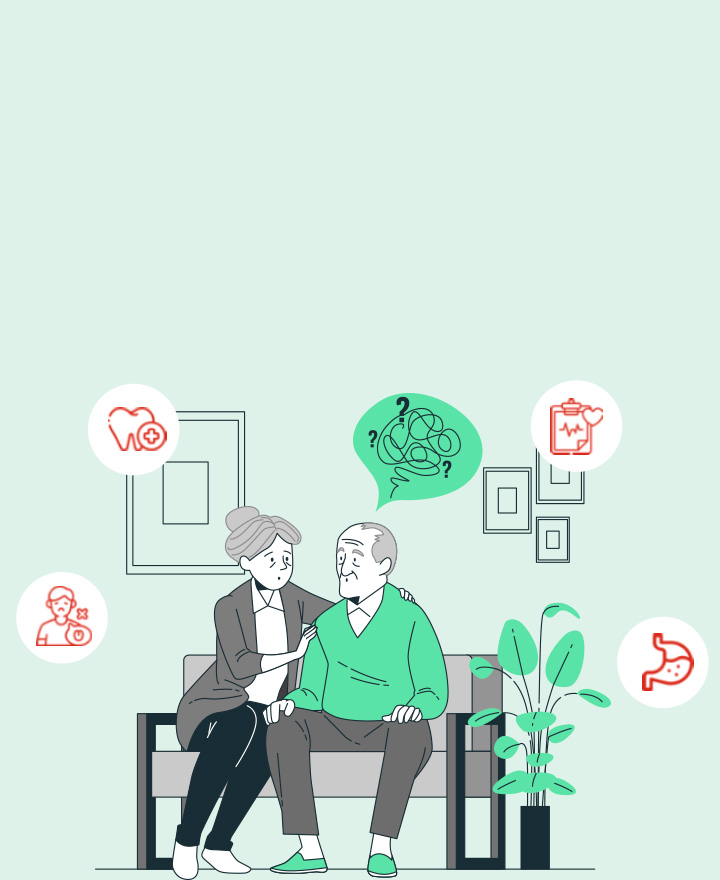

Anxiety in Old Age: Signs, Causes, and Care Tips
Anxiety in old age is more common than many realise. Many older adults silently struggle with constant worry, panic, or a deep fear of being alone, often brushing it off as “just stress” or a part of growing older. However, it doesn’t have to be that way. This blog will help you understand the various types of anxiety that can affect older adults, the signs to look out for, and practical ways to manage them. With the right support, lifestyle changes, and timely care, later years can be lived with peace of mind and emotional well-being. Read on to know more.
Types of Anxiety Disorders
Many older adults encounter different forms of anxiety at some point. Each type brings its own set of signs and difficulties. Here are the most common types:
1. Generalised Anxiety Disorder (GAD)
This type of anxiety brings a rush of thoughts that are hard to switch off. It leaves people constantly worrying about health, family matters, or financial issues. It can make it hard to sleep, focus, or enjoy daily activities. They might feel tired, irritated, or even a little sick.
2. Panic Disorder
People with panic disorder feel sudden waves of fear. These attacks can cause chest pain, fast heartbeat, and dizziness. Many mistake it for a heart problem.
3. Social Anxiety Disorder
This causes fear of being judged or embarrassed in public. It may stop someone from going out, meeting friends, or attending family events.
4. Phobias
These are intense, persistent fears of specific places, situations, or things. These fears are often not based on real danger but can still feel very real to the person experiencing them. For older adults, common phobias include fear of dying, fear that something bad will happen to loved ones or fear of disasters.
5. Post-Traumatic Stress Disorder (PTSD)
Older adults who have been through accidents, surgeries, or loss may carry trauma. This trauma may come back as flashbacks, nightmares, or strong emotional reactions.
6. Obsessive-Compulsive Disorder (OCD)
This involves unwanted thoughts and repetitive behaviours, such as checking locks or cleaning things excessively.
Symptoms To Watch Out For
Anxiety in older people may not always look the same as in younger adults. Some signs may be dismissed as age-related or attributed to other illnesses.
Watch out for these symptoms:
• Constant worrying
• Tired and worn out even after a good sleep
• Trouble falling or staying asleep
• Shortness of breath or tightness in the chest
• Poor memory and frequent stomach problems
• Hot flashes or excessive sweating
• Frequent headaches or feeling confused
• Blurry vision or eye discomfort
• Getting irritated or upset more easily
Older adults may also discuss physical complaints more frequently than emotional ones. They may not say, “I feel anxious,” but instead complain about body aches, fatigue, or trouble sleeping. If these signs stay for long or affect daily life, it may be anxiety. It’s also wise to have appropriate health insurance coverage in place, so medical consultations and treatments can be accessed without financial stress.
How to Manage It?
Anxiety is treatable. With the right steps, older adults can regain a sense of calm, support, and safety. Here are some ways to manage it:
1. Therapy
Cognitive Behavioural Therapy (CBT) is highly effective for many. It helps people recognise negative thought patterns and learn healthier ways to respond to them. Regular counselling also provides a safe space to discuss your fears, grief, or worries.
2. Stay Active
Even simple daily activities, such as taking a walk or practising yoga, can help boost your mood. Movement helps release feel-good chemicals in the brain, improves sleep, and supports overall well-being.
3. Eat and Sleep Well
Eating healthy foods and getting good sleep can do a lot to support both your body and your mind. Try to cut back on sweets, strong coffee, and too much alcohol.
4. Stay Connected
Spending time with family and friends softens the edges of loneliness. Make room for weekly calls, quick visits, or sign up for local clubs.
5. Mindfulness and Relaxation
Taking a few slow breaths, saying a short prayer, or sitting quietly for a brief meditation can help ease racing thoughts. Many free, guided recordings walk you through relaxation step-by-step, helping to melt away everyday tension.
For ongoing care and peace of mind, older adults can also benefit from dedicated senior citizen health insurance, which provides age-appropriate coverage for mental health consultations, medications, and hospital visits when needed.
Conclusion
Anxiety in the elderly is common, but it doesn’t have to take over life. With the right care, support, and small daily steps, it can get better. Getting help early makes a big difference. However, sometimes the cost of treatment or therapy can feel overwhelming in itself. This is where having a good health insurance plan can really help. It can ease financial stress so you can focus on feeling better.
Source: WebMD, ncoa.org, aagponline.org, cedars-sinai
Disclaimer: This blog provides general information and discussions about health and related subjects. The information and other content provided in this blog, website or in any linked materials are not intended and should not be considered, or used as a substitute for, medical advice, diagnosis or treatment. Kindly contact your Doctor before starting a new medicine or health regime.
Related Articles
Understanding Illness Anxiety Disorder (IAD)
Generalised Anxiety Disorder: Causes
Anxiety – Everything You Need to Know to Fight It
Published on August 06, 2025














 Health Insurance
Health Insurance  Travel Insurance
Travel Insurance  Car Insurance
Car Insurance  Cyber Insurance
Cyber Insurance  Critical Illness Insurance
Critical Illness Insurance
 Pet Insurance
Pet Insurance
 Bike/Two Wheeler Insurance
Bike/Two Wheeler Insurance  Home Insurance
Home Insurance  Third Party Vehicle Ins.
Third Party Vehicle Ins.  Tractor Insurance
Tractor Insurance  Goods Carrying Vehicle Ins.
Goods Carrying Vehicle Ins.  Passenger Carrying Vehicle Ins.
Passenger Carrying Vehicle Ins.  Compulsory Personal Accident Insurance
Compulsory Personal Accident Insurance  Travel Insurance
Travel Insurance  Rural
Rural